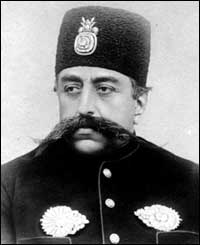Qajar Dynasty
Fath Ali Shah, 1797 - 1834 Under Fath Ali Shah, Iran went to war against Russia, which was expanding from the north into the Caucasus Mountains, an area of historic Iranian interest and influence. Iran suffered major military defeats during the war. Under the terms of the Treaty of Golestan in 1813, Iran recognized Russia's annexation of Georgia and ceded to Russia most of the north Caucasus region. A second war with Russia in the 1820s ended even more disastrously for Iran, which in 1828 was forced to sign the Treaty of Turkmanchai acknowledging Russian sovereignty over the entire area north of the Aras River (territory comprising present-day Armenia and Republic of Azerbaijan). Fath Ali's reign saw increased diplomatic contacts with the West and the beginning of intense European diplomatic rivalries over Iran. His grandson Mohammad Shah, who fell under the influence of Russia and made two unsuccessful attempts to capture Herat, succeeded him in 1834. When Mohammad Shah died in 1848 the succession passed to his son Naser-e-Din, who proved to be the ablest and most successful of the Qajar sovereigns.
During Naser o-Din Shah's reign Western science, technology, and educational methods were introduced into Iran and the country's modernization was begun. Naser o-Din Shah tried to exploit the mutual distrust between Great Britain and Russia to preserve Iran's independence, but foreign interference and territorial encroachment increased under his rule. He contracted huge foreign loans to finance expensive personal trips to Europe. He was not able to prevent Britain and Russia from encroaching into regions of traditional Iranian influence. In 1856 Britain prevented Iran from reasserting control over Herat, which had been part of Iran in Safavid times but had been under non-Iranian rule since the mid-18th century. Britain supported the city's incorporation into Afghanistan; a country Britain helped create in order to extend eastward the buffer between its Indian territories and Russia's expanding empire. Britain also extended its control to other areas of the Persian Gulf during the 19th century. Meanwhile, by 1881 Russia had completed its conquest of present-day Turkmenistan and Uzbekistan, bringing Russia's frontier to Iran's northeastern borders and severing historic Iranian ties to the cities of Bukhara and Samarqand. Several trade concessions by the Iranian government put economic affairs largely under British control. By the late 19th century, many Iranians believed that their rulers were beholden to foreign interests. Mirza Taghi Khan Amir Kabir, was the young prince Nasser o-Din's advisor and constable. With the death of Mohammad Shah in 1848, Mirza Taqi was largely responsible for ensuring the crown prince's succession to the throne. When Nasser o-Din succeeded to the throne, Amir Nezam was awarded the position of prime minister and the title of Amir Kabir, the Great Ruler. Iran was virtually bankrupt, its central government was weak, and its provinces were almost autonomous. During the next two and a half years Amir Kabir initiated important reforms in virtually all sectors of society. Government expenditure was slashed, and a distinction was made between the privy and public purses. The instruments of central administration were overhauled, and the Amir Kabir assumed responsibility for all areas of the bureaucracy. Foreign interference in Iran's domestic affairs was curtailed, and foreign trade was encouraged. Public works such as the bazaar in Tehran were undertaken. Amir Kabir issued an edict banning ornate and excessively formal writing in government documents; the beginning of a modern Persian prose style dates from this time. One of the greatest achievments of Amir Kabir was the building of Dar-ol-Fonoon, the first modern university in Iran. Dar-ol-Fonoon was established for training a new cadre of administrators and acquainting them with Western techniques. Amir Kabir ordered the school to be built on the edge of the city so it can be expanded as needed. He hired French and Russian instructors as well as Iranians to teach subjects as different as Language, Medicine, Law, Georgraphy, History, Economics, and Engeneering. Unfortunatelly, Amir Kabir did not live long enough to see his greatest monument completed, but it still stands in Tehran as a sign of a great man's ideas for the future of his country. These reforms antagonized various notables who had been excluded from the government. They regarded the Amir Kabir as a social upstart and a threat to their interests, and they formed a coalition against him, in which the queen mother was active. She convinced the young shah that Amir Kabir wanted to usurp the throne. In October 1851 the shah dismissed him and exiled him to Kashan, where he was murdered on the shah's orders.
When Naser o-Din Shah was assassinated by Mirza Reza Kermani in 1896, the crown passed to his son Mozaffar o-Din. Mozaffar o-Din Shah was a weak and ineffectual ruler. Royal extravagance and the absence of incoming revenues exacerbated financial problems. The shah quickly spent two large loans from Russia, partly on trips to Europe. Public anger fed on the shah's propensity for granting concessions to Europeans in return for generous payments to him and his officials. People began to demand a curb on royal authority and the establishment of the rule of law as their concern over foreign, and especially Russian, influence grew. The shah's failure to respond to protests by the religious establishment, the merchants, and other classes led the merchants and clerical leaders in January 1906 to take sanctuary from probable arrest in mosques in Tehran and outside the capital. When the shah reneged on a promise to permit the establishment of a "house of justice", or consultative assembly, 10,000 people, led by the merchants, took sanctuary in June in the compound of the British legation in Tehran. In August the shah was forced to issue a decree promising a constitution. In October an elected assembly convened and drew up a constitution that provided for strict limitations on royal power, an elected parliament, or Majles, with wide powers to represent the people, and a government with a cabinet subject to confirmation by the Majles. The shah signed the constitution on December 30, 1906. He died five days later. The Supplementary Fundamental Laws approved in 1907 provided, within limits, for freedom of press, speech, and association, and for security of life and property. The Constitutional Revolution marked the end of the medieval period in Iran. The hopes for constitutional rule were not realized, however. Mozaffar o-Din's son Mohammad Ali Shah (reigned 1907-09), with the aid of Russia, attempted to rescind the constitution and abolish parliamentary government. After several disputes with the members of the Majlis, in June 1908 he used his Russian-officered Persian Cossacks Brigade to bomb the Majlis building, arrest many of the deputies, and close down the assembly. Resistance to the shah, however, coalesced in Tabriz, Esfahan, Rasht, and elsewhere. In July 1909, constitutional forces marched from Rasht and Esfahan to Tehran, deposed the shah, and re-established the constitution. The ex-shah went into exile in Russia.
Ahmad Shah, was born 21 January 1898 in Tabriz, who succeeded to the throne at age 11, proved to be pleasure loving, effete, and incompetent and was unable to preserve the integrity of Iran or the fate of his dynasty. The occupation of Iran during World War I (1914-18) by Russian, British, and Ottoman troops was a blow from which Ahmad Shah never effectively recovered. With a coup d'état in February 1921, Reza Khan (ruled as Reza Shah Pahlavi, 1925-41) became the preeminent political personality in Iran; Ahmad Shah was formally deposed by the Majles (national consultative assembly) in October 1925 while he was absent in Europe, and that assembly declared the rule of the Qajar dynasty to be terminated. Ahamd Shah died later on 21 February 1930 in Neuilly-sur-Seine, France. Taken from the Iranian Chamber Society Website :http://www.iranchamber.com/history/constitutional_revolution/constitutional_revolution.php |
Sunday, September 13, 2009
The Qajar Dynasty
Subscribe to:
Post Comments (Atom)




3 comments:
Sammy, this article is hard to read because the words at the end of each line are cut and words are missing on each line.
-Rachana
It is interesting to learn how some countries’ boundaries are formed after wars and losing land, and how old and persistent is the idea that if you are stronger or have more power you can take over not only vast pieces of land but over entire nations. The desire for expansion and domination is very ancient, but where does it come from and why is it still present today. We still try to take over other countries’ land and resources even if it results in a lot of deaths. We have not learn the lessons of history that world domination only leads to devastation wars. If we learned the lessons of history, we could realize by studying countries like iran that foreign involvement only leads to deterioration of countries and political unrest. A government should be focused on how to improve it’s peoples way of life by providing education and relief with the resources available. Now with our war in Iraq, the US is looking like Britain and Russia who exploited and profited from Iran for so long.
Turns out you can read the post by copy/pasting into a word doc who knew!
So what I took away from this article was the long and tumultuous process leading up to the Constitutional revolution of 1906. I find it very impressive that the people themselves organized in the name of just law, and had their needs met through civil disobedience.
I also understand that it was the Qajar leadership's granting of concessions that led to this critical push for reform.
As much as I do see the weaknesses of the Qajar Dynasty--those that are amply spoken to in any account of history--I also see the necessity for the concessions to have been granted. There was no other way to develop and advance Iran without the help of nations posessing that critical knowledge, experience and technology.
Yet with development came debt and vulnerability to foreign interests.
Post a Comment